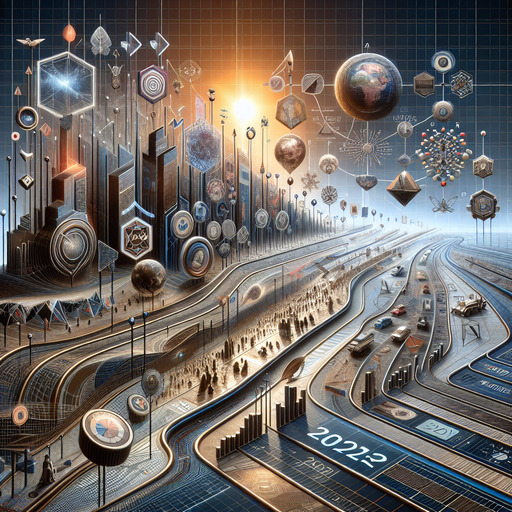
-
Table of Contents
Discover the Future of Web Design: Stay Ahead with 2024’s Hottest Trends! Learn More
Introduction
As we approach 2024, the landscape of web design continues to evolve, driven by technological advancements and changing user expectations. The upcoming year promises to bring a host of innovative trends that will shape the way websites are designed and experienced. From the integration of artificial intelligence and machine learning to the rise of immersive experiences through augmented and virtual reality, web design is set to become more dynamic and user-centric than ever before. Additionally, sustainability and accessibility are becoming paramount, influencing design choices that prioritize eco-friendly practices and inclusive user experiences. As designers and developers gear up for the future, staying ahead of these trends will be crucial in creating websites that are not only visually stunning but also highly functional and engaging.
Web Design Trends for 2024: What’s Coming Next
As we approach 2024, the landscape of web design continues to evolve, driven by technological advancements and changing user expectations. One of the most significant trends anticipated for the coming year is the increased emphasis on immersive experiences. Virtual reality (VR) and augmented reality (AR) are no longer confined to gaming and entertainment; they are making their way into web design, offering users a more engaging and interactive experience. This shift is expected to transform how users interact with websites, providing a more dynamic and personalized experience.
In addition to immersive experiences, minimalistic design remains a strong trend. However, the minimalism of 2024 is expected to be more refined and sophisticated. Designers are focusing on creating clean, uncluttered interfaces that prioritize functionality and user experience. This approach not only enhances the aesthetic appeal of a website but also improves its usability, making it easier for users to navigate and find the information they need. The use of white space, simple color schemes, and clear typography will continue to be key elements of this trend.
Another trend gaining traction is the integration of artificial intelligence (AI) and machine learning into web design. AI-powered chatbots and virtual assistants are becoming more prevalent, providing users with instant support and personalized recommendations. These technologies are not only improving customer service but also enhancing the overall user experience by making websites more intuitive and responsive. As AI continues to advance, we can expect to see even more sophisticated applications in web design, such as predictive analytics and personalized content delivery.
Furthermore, accessibility is becoming an increasingly important consideration in web design. With a growing awareness of the need to make the web accessible to all users, designers are focusing on creating websites that are inclusive and user-friendly for people with disabilities. This includes implementing features such as screen reader compatibility, keyboard navigation, and high-contrast color schemes. By prioritizing accessibility, designers are not only complying with legal requirements but also ensuring that their websites can be used by a wider audience.
Sustainability is another trend that is expected to shape web design in 2024. As concerns about the environment continue to grow, designers are looking for ways to reduce the carbon footprint of their websites. This includes optimizing images and videos to reduce load times, using energy-efficient hosting services, and minimizing the use of resource-intensive features. By adopting sustainable design practices, designers can create websites that are not only environmentally friendly but also more efficient and user-friendly.
Moreover, the rise of mobile-first design is set to continue in 2024. With more users accessing the web via mobile devices, it is essential for websites to be optimized for smaller screens. This means designing with a mobile-first approach, ensuring that websites are responsive and provide a seamless experience across all devices. This trend is not only about making websites look good on mobile devices but also about improving their performance and usability.
In conclusion, the web design trends for 2024 reflect a growing emphasis on creating more immersive, user-friendly, and sustainable websites. By embracing these trends, designers can stay ahead of the curve and deliver exceptional experiences that meet the evolving needs of users. As technology continues to advance, it will be exciting to see how these trends develop and shape the future of web design.
Q&A
1. **What are the anticipated web design trends for 2024?**
– **Dark Mode Dominance**: Increased use of dark mode for better user experience and energy efficiency.
– **AI and Machine Learning Integration**: Enhanced personalization and interactivity through AI-driven content and design elements.
– **3D and Immersive Experiences**: More 3D elements and immersive web experiences using AR/VR technologies.
– **Minimalism and Simplified UX**: Clean, simple designs with intuitive navigation to improve user engagement.
– **Micro-Interactions**: Subtle animations and feedback to enhance user interaction and engagement.
– **Voice User Interface (VUI)**: Growing incorporation of voice search and commands in web design.
– **Sustainable Web Design**: Focus on eco-friendly design practices to reduce the carbon footprint of websites.
– **Neumorphism**: A blend of skeuomorphism and flat design for a soft, realistic look.
– **Advanced Typography**: Creative and bold typography to make content stand out.
– **Asymmetrical Layouts**: Unique, non-traditional layouts to create visually interesting designs.